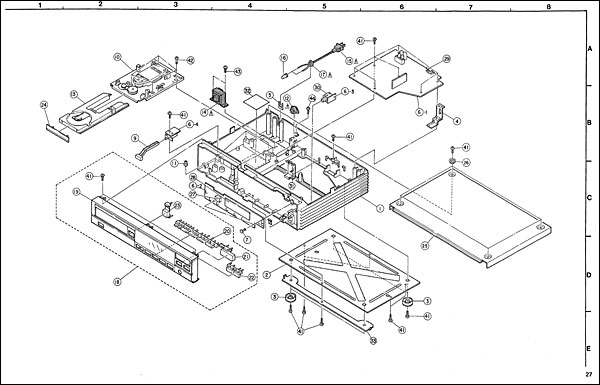Denon DCD-600 CD Player

 Putting its re-badged CD players behind it, in 1987 Denon unveiled a machine to take on models from the brands that first brought CD to the market. How will it shape-up today?
Putting its re-badged CD players behind it, in 1987 Denon unveiled a machine to take on models from the brands that first brought CD to the market. How will it shape-up today?
Early CD players from Philips and Sony are considered by some collectors to be the most covetable vintage models because they came from the very companies that created the format. You can add to this list machines from Denon, whose Pulse Code Modulation (PCM) system underpinned the way analogue signals were transformed into digital data, recorded, played back and finally turned back into music again.
PCM was first demonstrated by Denon as far back as 1970, so its use preceded the introduction of the CD by over a decade. To begin with, the only machines with the capacity to capture the high-speed data generated by the PCM system were industrial video recorders, but a lot was learned from how these machines were used in professional environments.

CD Dream Team
The combination of Philips' expertise with laser optics and servo tracking systems, Sony's highly developed error-correcting strategies and Denon's PCM code is what made the Compact Disc a success. Oddly though, Denon was not fully at the party when the format was launched. Philips and Sony showed players entirely of their own design and manufacture, but this was beyond Denon at the time. Nevertheless, the DCD-600, launched in 1987 and reviewed here, gives an idea of how far the company would progress in just a few short years following the release of its debut machine – the DCD-2000 – in 1982. After all, the DCD-2000 was a lightly disguised Hitachi DA-1000 [HFN Sep '16], made by Hitachi in its own factories.
A year after the DCD-2000 came the DCD-1800, which was an original design offered as a top-end model. Here Denon was perhaps unique in its attempt to emulate the Philips swing-arm optical mechanism in preference to the motor-powered linear sled usually employed by the big Japanese firms. Although elegant, the system was complex and not as readily adaptable to mass production as the Philips version (with which it shared no common parts – the laser itself came from Toshiba). It was soon dropped from Denon's players.

The DCD-600 was typical of the sort of midrange player that the more serious listener would choose instead of a packaged system. It was neat, stylish and fully featured without being extravagant. A CD player of any description was still a luxury product at this time and the DCD-600 showed the benefits of spending a little more on this important purchase.
Transport Union
The DCD-600 arrived with a traditional three-beam laser pick-up sourced from Sony but fitted to a Denon-designed transport. The bulk of the servo and decoding electronics also came from Sony, which by this time could offer a range of specialised ICs (and the technical backup to enable the best use to be made of them) to allow a CD player to be designed with the minimum of cost and fuss. An intriguing detail of the design is that the decoder IC, which also contained the digital filter, was mounted on a small daughter board, so presumably the designers intended that this part could be updated without the need for the whole PCB to be re-drafted.

The DAC came from Burr-Brown and was a standard 16-bit linear type, time-shared between the two channels. A 2x oversampling digital filter was employed to minimise the adverse effects this layout might have on the phase relationship between the two channels – a common refinement to the better class of Japanese player at the time. If this had been all there was to the DCD-600 it would have been just another 'me too' player, but this being a Denon product, there was a little more to the design that – enough, in fact, to make it a really noteworthy machine.
Firstly, the facility to further linearise the Burr-Brown DAC had been fully implemented. The chip included extra connections to which a network of components could be fitted to trim out the last of the ladder DAC's linearity errors. Most other users of this chip simply ignored this option, but its inclusion is a common feature of many Denon designs of this era. It was known as the Super Linear Converter.

Hold In Play
The second refinement tackled head-on the phase-lag problem between the two channels, which with a conventional machine with a 2x oversampling filter would amount to about 45° at 20kHz. This is a similar goal to that pursued in the Technics SL-P3 player [HFN Sep '22] with its analogue frequency-dependent phase shifting circuit. The Denon approach differed to this in that it made use of circuitry that already existed in every machine of the single-DAC type.
All such designs use a 'sample and hold' circuit, which briefly stores the analogue value of the output of the DAC while the other channel is updated. One sample-and-hold arrangement in each channel ensures a smooth flow of analogue signal from both the left and right output, although the slight delay between each remains.
Denon solved this problem by adding a further sample-and-hold circuit in the left channel only, making the two channels asymmetrical (which is unusual in the analogue sections of hi-fi equipment). The action of this was precisely synchronised to the single sample and hold in the right channel, meaning both outputs were always perfectly in step. This refinement, added little in terms of cost, component count and complexity, but enabled the player to finally rival the exact channel matching of the Philips/Marantz machines, which had one DAC each for left and right.























































